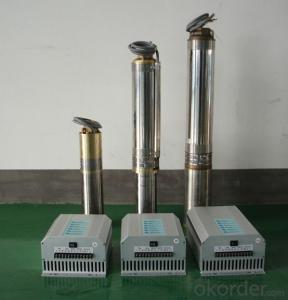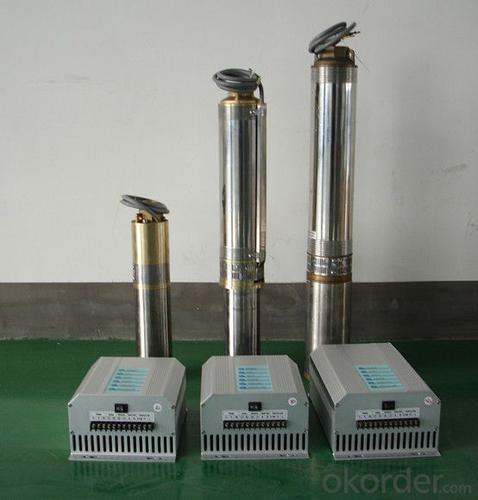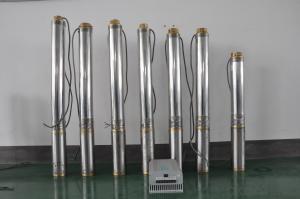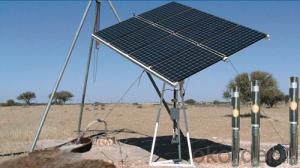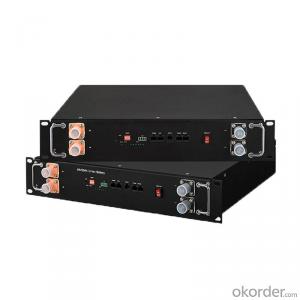DC Solar Water Pump
- Loading Port:
- China Main Port
- Payment Terms:
- TT OR LC
- Min Order Qty:
- -
- Supply Capability:
- -
OKorder Service Pledge
OKorder Financial Service
You Might Also Like
Item Description :
This superb new addition to our solar fountain range comes with a 10w solar panel,and a powerful fountain pump that is capable of producing fountains of up to 2m in height. As well as being easy to set up and use.Instruction manual is supplied for assembly and maintenance.
Solar Fountain Key Features :
Powered by direct sunlight
No high voltage electric mains required
Safe for children
Max. height of fountain: 2M
Max. flow capacity: 800 L/H(176 GAL)
10W Polycrystalline solar panel included
18V DC brushless pump
Solar Pump Features :
Can produce fountains up to : 2M (tube height) 1.4M (fountain height)
Comes with multiple nozzle accessories
Cable Length : 5M
Solar Panel Features :
10W peak power.
Polycrystalline highly efficient solar panel
Comes mounted in aluminium frame
Comes with ground stake and rotating knob so you can angle your panel toward the sun
What You Will Get :
10W solar panel
Solar pump
Ground Sake
Nozzle accessories
Precautions :
DO NOT alter or change the product itself or its components
Operate pump in freshwater only, never above 50 degrees celsius
Keep away from flammable liquids
Do not connect to any other power supply other than the included
- Q:Can a solar pump be used for water supply in agricultural research facilities?
- Certainly, water supply in agricultural research facilities can be achieved using a solar pump. Solar pumps offer an efficient and environmentally-friendly alternative to traditional pumps that rely on electricity or fuel. By harnessing solar energy, these pumps can operate in remote areas or places with limited access to electricity. In agricultural research facilities, solar pumps can fulfill various water supply needs such as irrigation systems, hydroponic setups, or livestock watering. Depending on the facility's requirements, they can be easily integrated into existing infrastructure or used as independent systems. Solar pumps bring long-term cost-effectiveness by reducing energy expenses, while also playing a significant role in lowering carbon emissions and lessening dependence on fossil fuels. Moreover, they require minimal maintenance and boast a lengthy lifespan, making them a dependable solution for water supply in agricultural research facilities.
- Q:Can a solar pump be used in areas with high air pollution levels?
- Yes, a solar pump can be used in areas with high air pollution levels. Solar pumps rely on sunlight to generate power, and they do not require combustion or rely on air quality for their functionality. As long as there is sufficient sunlight reaching the solar panels, the pump can operate efficiently regardless of the air pollution levels in the area.
- Q:Can a solar pump be used for water supply in refugee camps or disaster relief areas?
- Certainly, a solar pump can be utilized for water supply in refugee camps or disaster relief regions. These scenarios greatly benefit from the use of solar pumps as they depend on sunlight to generate power and do not necessitate a continuous supply of electricity. Consequently, they prove to be ideal for remote locations or areas with limited access to conventional power sources. Solar pumps can be employed to extract water from wells, boreholes, or other water sources and can be configured to ensure a dependable and sustainable water supply. Typically, these pumps are equipped with photovoltaic panels that convert sunlight into electricity, thus empowering the pump to draw water from underground sources. The utilization of solar pumps in refugee camps or disaster relief areas presents several advantages. Firstly, they are environmentally friendly, given that they do not emit greenhouse gases or contribute to air pollution. Additionally, solar pumps require minimal maintenance and boast a long lifespan, thereby reducing operational costs and the need for constant repairs. Moreover, solar pumps often incorporate built-in water purification systems, guaranteeing that the extracted water is clean and safe for consumption. This is especially crucial in disaster-stricken areas or refugee camps where access to clean water is vital for basic hygiene and the prevention of waterborne diseases. In conclusion, solar pumps prove to be an exceptional option for water supply in refugee camps or disaster relief areas due to their reliance on sunlight, user-friendliness, low maintenance requirements, and ability to provide clean and sustainable water. They offer a practical and cost-effective solution to address water scarcity in these challenging environments.
- Q:Are there any limitations to the size of particles a solar pump can handle?
- Yes, there are limitations to the size of particles a solar pump can handle. Solar pumps typically have a filtration system to prevent large particles from entering the pump and causing damage. However, the specific limitations vary depending on the design and capacity of the pump. It is important to check the manufacturer's specifications and recommendations to ensure that the pump can handle the size of particles present in the water source.
- Q:Are there any compatibility issues with integrating a solar pump into an existing water system?
- When integrating a solar pump into an existing water system, compatibility issues may arise. Common issues include the following: 1. Power requirements: Efficient operation of solar pumps typically relies on specific voltage and current inputs. If the existing water system cannot provide the required power, modifications or upgrades may be necessary to accommodate the solar pump. 2. Water flow rate: It is important to ensure that the existing water system can handle the desired flow rate of the solar pump without causing pressure or performance problems, as solar pumps have specific flow rate capacities. 3. Pipelines and fittings: The pipelines and fittings in the existing water system may not be suitable for connecting with a solar pump in terms of size and type. In such cases, proper integration may require modifications or the addition of adapters. 4. Control systems: Solar pumps often come with their own control systems, such as solar controllers, inverters, or sensors. Integrating these control systems with the existing water system may necessitate additional wiring or modifications to the current control infrastructure. 5. Voltage compatibility: If the existing water system operates on a different voltage from the solar pump, a voltage converter or transformer may be needed to ensure safe operation and compatibility. To ensure a seamless integration and avoid compatibility issues, it is advisable to consult with a professional or the manufacturer of the solar pump. They can assess the existing water system and determine the necessary modifications or upgrades required.
- Q:Do solar pumps require any additional equipment?
- Yes, solar pumps typically require additional equipment such as solar panels, controllers, batteries, and in some cases, a storage tank or filter system.
- Q:How does the quality of the solar panel affect the performance of a solar pump?
- The quality of the solar panel directly affects the performance of a solar pump. A high-quality solar panel will efficiently convert sunlight into electricity, providing a consistent and reliable power supply to the solar pump. This ensures optimal performance and maximum water flow. On the other hand, a low-quality solar panel may have lower efficiency and produce less power, resulting in reduced pump performance and potentially insufficient water supply.
- Q:Are there any limitations to the distance a solar pump can pump water?
- The distance that a solar pump can pump water is subject to limitations. The primary limitation is the power output of the solar panels. Solar pumps rely on solar energy to generate electricity, which is used to power the pump. As the distance between the pump and the solar panels increases, the energy transfer capacity decreases. Consequently, the pump may not have enough power to pump water over long distances. Moreover, the size and power of the pump itself are also influential factors in determining the maximum distance it can pump water. Smaller pumps may have limited pumping capabilities and may face difficulties in pushing water over extended distances, particularly if there are significant changes in elevation. Furthermore, various other factors, including the terrain, pipe diameter, and the presence of obstacles, can impact the effective pumping distance of a solar pump. For instance, if the pumping route includes steep inclines or rough terrain, the pump may struggle to overcome resistance and maintain the necessary pressure for efficient water movement. Therefore, while solar pumps can offer an efficient and sustainable solution for water pumping, it is crucial to consider the limitations related to power output, pump size, and other factors that may impose restrictions on the pump's effective operating distance.
- Q:Can solar pumps be used for geothermal heating or cooling systems?
- No, solar pumps cannot be used for geothermal heating or cooling systems. Geothermal systems require specialized equipment such as geothermal heat pumps to harness the heat from the ground, whereas solar pumps are designed to utilize solar energy for water pumping purposes.
- Q:What is the expected energy payback time of a solar pump system?
- The duration for a solar pump system to generate the same amount of energy it needed for manufacturing and installation is referred to as the expected energy payback time. This timeframe is influenced by several factors, such as the efficiency of the solar panels, the size and capacity of the pump system, and the location and climate conditions of the installation. Typically, a well-designed and properly maintained solar pump system can achieve an energy payback time ranging from 2 to 5 years. However, it's important to note that this estimate can vary significantly depending on the specific circumstances. In areas with ample sunlight and high water demands, a solar pump system can achieve a faster energy payback time due to increased energy production and utilization. Conversely, regions with less sunlight or lower water requirements may experience a longer energy payback time. Furthermore, advancements in solar technology and improvements in efficiency can also contribute to reducing the energy payback time of a solar pump system. As solar panels become more efficient and manufacturing processes become more sustainable, the time required to recover the initial energy investment decreases. It is crucial to consider the long-term benefits of a solar pump system beyond the energy payback time. Once the system surpasses this duration, it continues to generate clean and renewable energy with minimal maintenance and operating costs, contributing to energy savings and environmental sustainability for many years to come.
1. Manufacturer Overview |
|
|---|---|
| Location | |
| Year Established | |
| Annual Output Value | |
| Main Markets | |
| Company Certifications | |
2. Manufacturer Certificates |
|
|---|---|
| a) Certification Name | |
| Range | |
| Reference | |
| Validity Period | |
3. Manufacturer Capability |
|
|---|---|
| a)Trade Capacity | |
| Nearest Port | |
| Export Percentage | |
| No.of Employees in Trade Department | |
| Language Spoken: | |
| b)Factory Information | |
| Factory Size: | |
| No. of Production Lines | |
| Contract Manufacturing | |
| Product Price Range | |
Send your message to us
DC Solar Water Pump
- Loading Port:
- China Main Port
- Payment Terms:
- TT OR LC
- Min Order Qty:
- -
- Supply Capability:
- -
OKorder Service Pledge
OKorder Financial Service
Similar products
New products
Hot products
Hot Searches
Related keywords
